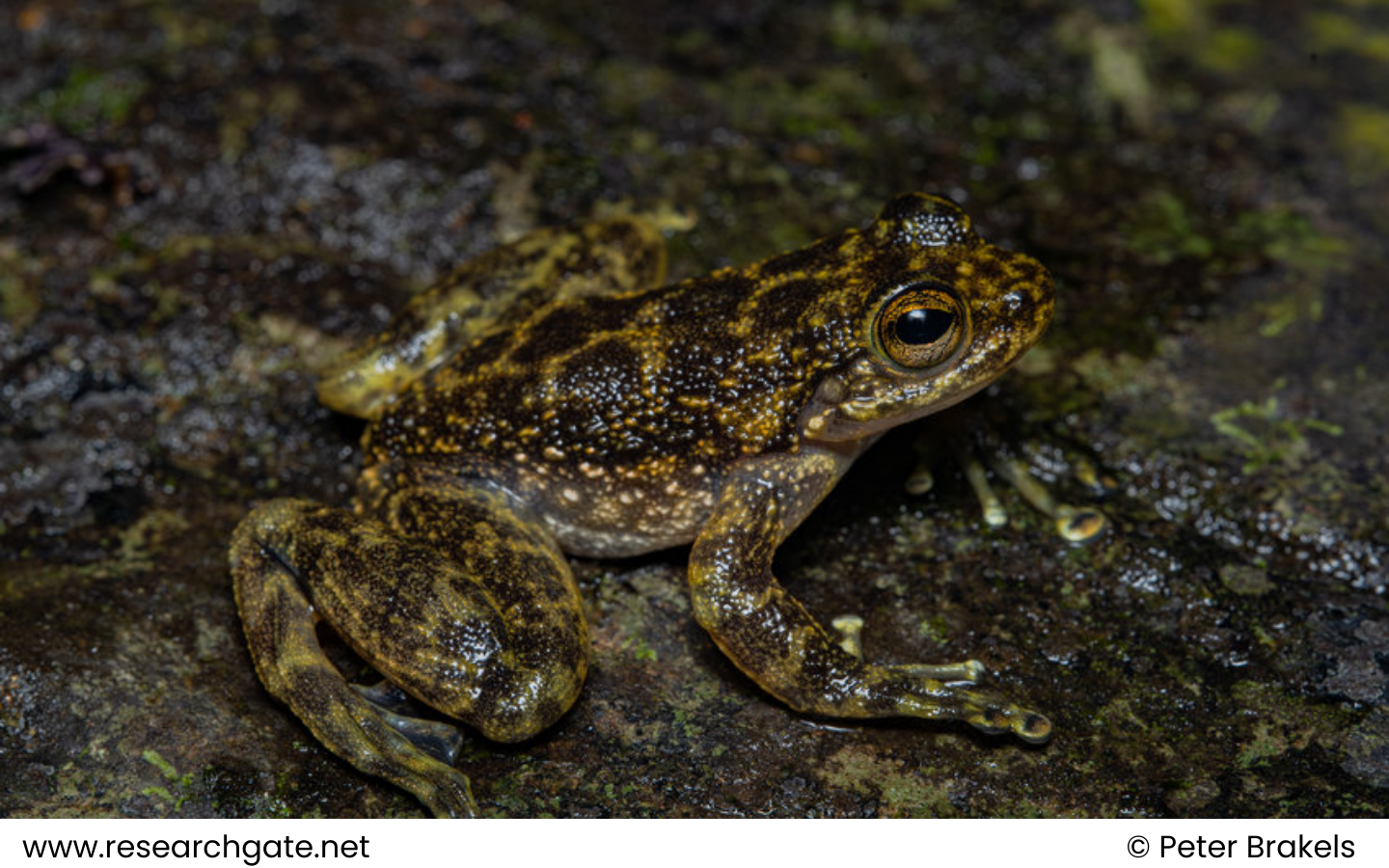
Science name: Amolops spinapectoralis – Inger, Orlov & Darevsky, 1999
Taxonomic: Animalia>> Chordata>> Amphibia>> Anura >> Ranidae >> spinapectoralis
Species status: Endemic ; IUCN status: LC (Least Concern)
Description:
Amolops spinapectoralis is a medium-sized frog with a robust build.
Size:
Males: Snout-vent length (SVL) ranges from 36.9 to 37.88 mm.
Females: SVL ranges from 41.64 to 45.15 mm.
Head: The head is broader than it is long, with the following dimensions: head width 14.34–16.87 mm, head length 13.73–16.11 mm. The snout is rounded.
Eyes: The eyes are large, with a diameter larger than the snout length and interorbital distance.
Eye diameter: 5.57–6.67 mm
Snout length: 5.01–6.19 mm
Interorbital distance: 3.3–4.3 mm
Forelimbs: The fingers are not webbed and have truncated discs.
Relative finger lengths: I<IV<IIDistribution and habitat: Elevation:
Amolops spinapectoralis, commonly known as a torrent frog species, is found at elevations between 647 and 1,722 meters above sea level.
Area:
This species is native to central Vietnam and has been recorded in several provinces, including Gia Lai, Quang Nam, Quang Ngai, Kon Tum, and Da Nang. It is likely that the species’ range extends into adjacent areas in the Vietnamese Central Highlands and possibly southeastern Laos and northeastern Cambodia, given similar habitats in these regions.
Habitat:
Amolops spinapectoralis inhabits montane evergreen forests and is closely associated with wet vertical rock faces adjacent to waterfalls and swiftly flowing streams. This species is often found near cascade streams, and its reproduction is thought to occur in these aquatic environments, where eggs are likely deposited.
Behaviour and ecology:
Lifestyle:
Amolops spinapectoralis is associated with aquatic environments, often living near cascade streams in montane forests. It is presumed to reproduce by depositing eggs in streams, with recently metamorphosed individuals observed in April. The frog feeds on insects and other small invertebrates found in its environment.
Conservation and status:
IUCN Red List Category and Criteria:
Amolops spinapectoralis is listed as Least Concern on the IUCN Red List due to its relatively wide distribution and presence in multiple locations.
Population Trend:
The population is currently decreasing, mainly due to habitat loss and degradation caused by deforestation and agricultural expansion.
Threats:
Habitat Loss: The species faces threats from deforestation, agricultural activities, and infrastructure development that alter its forest stream habitats.
Habitat Degradation: Changes in water quality and availability in streams, combined with forest loss, contribute to the species’ decline.
Conservation Actions:
Further Research: Additional surveys are needed to clarify the species’ distribution, population size, and life history.
Habitat Protection: Conservation of montane evergreen forests and streams is vital for the species’ continued survival.
Crocodile Trail – The Best Birding Trail in Cat Tien National Park
If you’re a birder or nature photographer planning a trip to Vietnam, few places offer [...]
Cong Troi Trail – Top 1 Dalat Plateau Birding Trail Experience
If you’re a birder or nature photographer planning a trip to Vietnam’s Central Highlands, the [...]
How to Identify the Greater Sand Plover, Tibetan Sand Plover and Siberian Sand Plover
Identification Differences within the Sand Plover Complex: The sand plover group, which was traditionally divided [...]
Highlights of Cat Tien National Park Reptiles and Amphibian Endemics
Spanning over 71,350 hectares of tropical forests, grasslands, and wetlands, Cat Tien National Park is [...]
Highlights of Cat Tien National Park Mammals in a World Biosphere Reserve
In addition to reptiles and birds, Cat Tien National Park is also rich in mammals, [...]
Kontum Plateau Endemic and Highlight bird
Kontum Plateau Endemic And Highlight Bird species like Chestnut-eared Laughingthrush and top birding routes while [...]